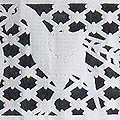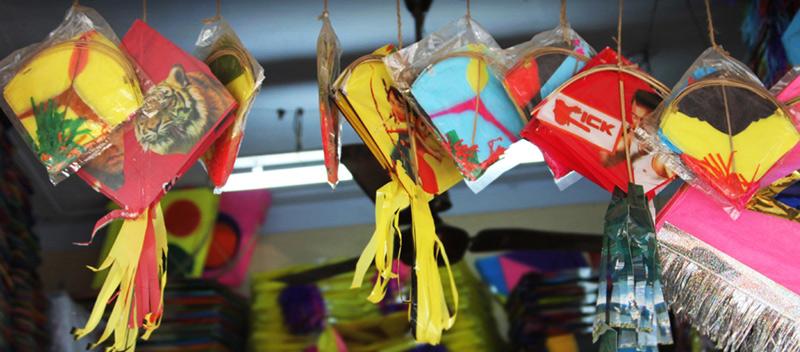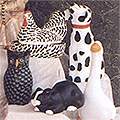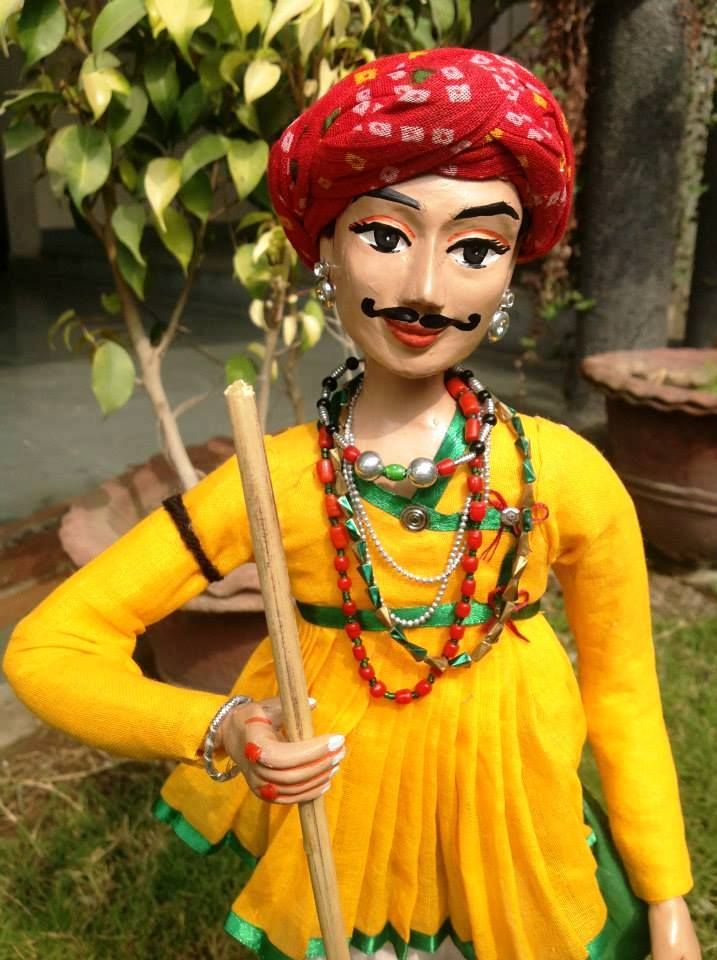Durries - made from cotton warp and jute, coir, wool, and occasionally, unrefined silk weft - are flat and pile-less floor coverings common in Indian homes. They are also used on the Indian newar charpoy/ traditional bamboo frame bed. Different parts of the country have localized durrie traditions; the particular combination of weaving technique, weft material, pattern stylisation, and motifs and colours used in different areas creates several interesting kinds ofdurries. The Panja durries are one among a multitude of styles; they are defined essentially by the use of the panja in weaving them, and known for fairly bold colors and patterns. The dhurries are made on simple horizontal looms in a weft-faced plain weave which gives it a sturdy, flat appearance. The multiple forms and colors of the patterns are created through the use of independent wefts, beaten into place with a panja, metal beater The weaving of durries in the Punjab is linked with the tradition of a household craft (like phulkari weaving) for personal use in the home, to be given as gifts, and as part of wedding trousseaus. Dhurries were also woven for the gurudwara/Sikh temples by groups of women. The Bridal dhurries drew on a large repertoire of indigenous motifs that continue to be based on the local flora and fauna. Now Panja durrie weaving is rarely practiced at home, transformed after the Partition of India immigrant weavers from Sailkot, Pakistan, arrived at Nakodar, Noor Mahal and the villages around it to settle down and start work for sale and export. In Nakodar two types of cotton dhurries are woven-bed dhurries are woven on a pit loom in multi colored stripes, and the floor dhurries, woven mostly in two contrasting colors on an adda, floor loom. Dhurrie patterns tend to be either geometrical or figurative. While the latter may employ a number of colours, the geometrical patterns are usually executed in two contrasting colours. The motifs used in both, however, derive from the folk vocabulary of birds, beasts, plants and the embroidered phulkari textiles. Several important centres of durrie making in pre-Independence Punjab are now in Pakistan; however, in present-day Punjab, the areas around Moga, Batal, Ludhiana, Hoshiarpur, Faridkot and Bhatinda are also fairly prolific and well-known. In Jalandhar District the areas of Nakodar, Mehtpur, Aulka, Bathanmehma, Ungi, Chak Bendal, Noor Mahal, and Sidma; in Ropar District the villages and towns of Losari, Jhandia Khurd, and Anandpur Sahib and Tarn Taran in Amritsar District The volume of production has changed substantially, and though women are still involved in weaving these durries, the production for sale and export is usually organised by men, with craftsmen hiring and training weavers in workshops. Indeed, Panja durrie-making, like several other crafts that began as household or folk crafts has become a profession and livelihood for many As for the history of the craft in India, theories vary, with some interpretations indicating an indigenous origin for durrie weaving and use in India and dating it to the early centuries A.D. Others stress a Persian origin - the word durrie being read as a form of doru, a floor covering in Persian. According to the historical opinion of George Watt and Percy Brown, it seems as if durries made of cotton warp and weft had an indigenous origin; however new techniques, materials and designs are believed to have been introduced into the indigenous durrie-making tradition with the coming of Turkish and Mughal influences into India.
Papier- Mache in Jammu and Kashmir is locally known as kar-e-kalamdani, meaning pen case work taking from its Iranian name. In the earlier days the craft was practiced on wooden panels of walls and wooden furniture. Later on it was adapted to paper-moulds as well. Products like boxes, toys, jewellery box, lamps, pen cases, wall decoration, powder containers, mirror cases, Christmas decorations, flowers vases, kettles, trays and plates and samovar- fluted kettle. The tools used by the craftsmen are file, rasp, hacksaw, sandpaper, burnishing stone, paintbrushes..
Pakistan produces a wide variety of products crafted from paper and papier mache.
In Bhutan, paper-making was traditionally practised as a domestic activity. Paper was made entirely by hand from the bark of the Daphne plant and gum from a creeper root. Often the Daphne bark was mixed together with other barks and roots to yield different varieties of paper. What made the Daphne paper special was its luminosity and texture and the quality of its being termite and insect repellent - it was thus particularly valued for writing religious scriptures and historical records. The National Museum, Paro has a collection of rare manuscripts written on Daphne paper. The National Library contains about 6,100 Tibetan and Bhutanese books, both manuscripts and xylographs and a collection of 9,000 printing boards.
- The method widely used throughout the Himalayas produces paper called resho, or 'cotton paper'. The process begins with the pouring and sieving of the pulp onto a cotton screen; it is then spread uniformly over the cotton surface while floating in water. This manoeuvre requires dexterity and practice. The screen and the pulp are then left to dry, which takes half a day, before the sheet of paper can be taken off. If the weather is wet and cold the drying is done by lighting wood-fires and placing the frames around these. After removing the mould from the water, it is held aloft for a few minutes to drain out the excess water. It is then placed tilted on the ground and allowed to dry in the sun or near a fire. Once dry, the sheet of paper is peeled off the cloth and the mould can be reused. The paper sheet is now ready.
- The other method of making paper is only used in Bhutan and produces a kind of paper called tsasho, or 'bamboo paper'. A screen made from slim bamboo mat/sticks is lowered into the vat of pulp; the wooden frame and bamboo mesh are vigorously moved, the paper-maker then lifts it out and spreads the pulp over the surface of the screen while it is out of the water. The screen is subsequently turned over, and the sheet that has formed on it drops off and is put on a growing pile of freshly made paper. The mesh, pressed and left to drain the remaining water, leaves a bamboo imprint on the sheet. At the end of the day, a stone is placed on the pile to help the water drain out of it during the night. The next day, the sheets are peeled off one by one and stuck to earthen walls of a hut, built for this purpose. By the end of the day the sheets are dry and fall off the wall. Today, dryers are being used to dry the sheets and speed up the process.
Jungshi Paper Manufacturing Company P Box No 506, Thimpu Bhutan Tel: 975 - 2 - 323431, 321442® E-mail: [email protected] Mangala Handmade Paper House Opposite the river, (Above Jungshi Paper Manufacturing Company) Thimpu, Bhutan
 |
 |
 |
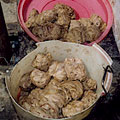 |
 |
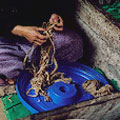 |
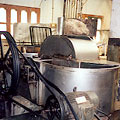 |
 |
 |
 |
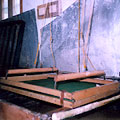 |
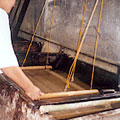 |
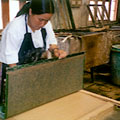 |
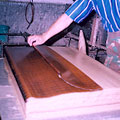 |
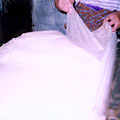 |
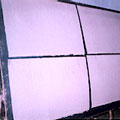 |
India's paper tradition has an antiquity of nearly a thousand years. Even though, it is presently caught in a struggle between the changing past and an unknown future, India still has the largest population of hand paper makers in the world.Traditionally, several paper mill establishments cropped up in parts of the country to help benefit from the rich forest resources of the region.
Today, paper and its products have grown and developed multi-fold due to several design and technique manipulations from folding, cutting, dyeing, recycling, layering and quilling.
India's paper tradition has an antiquity of nearly a thousand years. Even though, it is presently caught in a struggle between the changing past and an unknown future, India still has the largest population of hand paper makers in the world.Traditionally, several paper mill establishments cropped up in parts of the country to help benefit from the rich forest resources of the region.
Today, paper and its products have grown and developed multi-fold due to several design and technique manipulations from folding, cutting, dyeing, recycling, layering and quilling.
India's paper tradition has an antiquity of nearly a thousand years. Even though, it is presently caught in a struggle between the changing past and an unknown future, India still has the largest population of hand paper makers in the world.Traditionally, several paper mill establishments cropped up in parts of the country to help benefit from the rich forest resources of the region.
Today, paper and its products have grown and developed multi-fold due to several design and technique manipulations from folding, cutting, dyeing, recycling, layering and quilling.
India's paper tradition has an antiquity of nearly a thousand years. Even though, it is presently caught in a struggle between the changing past and an unknown future, India still has the largest population of hand paper makers in the world.Traditionally, several paper mill establishments cropped up in parts of the country to help benefit from the rich forest resources of the region.
Today, paper and its products have grown and developed multi-fold due to several design and technique manipulations from folding, cutting, dyeing, recycling, layering and quilling.
India's paper tradition has an antiquity of nearly a thousand years. Even though, it is presently caught in a struggle between the changing past and an unknown future, India still has the largest population of hand paper makers in the world.Traditionally, several paper mill establishments cropped up in parts of the country to help benefit from the rich forest resources of the region.
Today, paper and its products have grown and developed multi-fold due to several design and technique manipulations from folding, cutting, dyeing, recycling, layering and quilling.

India's paper tradition has an antiquity of nearly a thousand years. Even though, it is presently caught in a struggle between the changing past and an unknown future, India still has the largest population of hand paper makers in the world.Traditionally, several paper mill establishments cropped up in parts of the country to help benefit from the rich forest resources of the region.
Today, paper and its products have grown and developed multi-fold due to several design and technique manipulations from folding, cutting, dyeing, recycling, layering and quilling.
India's paper tradition has an antiquity of nearly a thousand years. Even though, it is presently caught in a struggle between the changing past and an unknown future, India still has the largest population of hand paper makers in the world.Traditionally, several paper mill establishments cropped up in parts of the country to help benefit from the rich forest resources of the region.
Today, paper and its products have grown and developed multi-fold due to several design and technique manipulations from folding, cutting, dyeing, recycling, layering and quilling.
India's paper tradition has an antiquity of nearly a thousand years. Even though, it is presently caught in a struggle between the changing past and an unknown future, India still has the largest population of hand paper makers in the world.Traditionally, several paper mill establishments cropped up in parts of the country to help benefit from the rich forest resources of the region.
Today, paper and its products have grown and developed multi-fold due to several design and technique manipulations from folding, cutting, dyeing, recycling, layering and quilling.
India's paper tradition has an antiquity of nearly a thousand years. Even though, it is presently caught in a struggle between the changing past and an unknown future, India still has the largest population of hand paper makers in the world.Traditionally, several paper mill establishments cropped up in parts of the country to help benefit from the rich forest resources of the region.
Today, paper and its products have grown and developed multi-fold due to several design and technique manipulations from folding, cutting, dyeing, recycling, layering and quilling.
The art of paper cut designs has been a popular form of decoration on religious occasions, weddings and other social ceremonies. Before the use of paper became common, leaves and grass were used. With the introduction of paper, the craft came to be known as Kagojer jhalot. The professional craftsmen who are skilled in this art are known as Kagoji or Jhaloti. Occasionally, non-professionals or amateurs also work at this art, inspired by religious or social obligations. When they decorate tazias for Muharram or a kirtan stage at the Ras Lila festival of the Manipuris or at a wedding ceremony, both professional artisans and amateurs compete with each other.
Patang is the local word for a kite. The largest hub of kite production is Gujarat. Vadodara, Surat and Ahmedabad are the majr cities which are known for their kite markets. Although in India kite flying is indulged mostly on special occasions such as 'Makar Sakranti', kite markets in Gujarat are always on boom. Kites for Uttarayan are made from a special lightweight paper which ads velocity to the flight of the kite. The kite festival in Gujarat is an amazing spectacle. People from all over the globe come to enjoy the sight of the vibrant colours and patterns on these kites flowing in the air. The craft production of the kites dates back to the historic reign of the Mughal empire. The first centers of production were set up in Ahemadabad. The community of people who indulged in this craft was called Patangbaaz. The initial shape of the kite was that of a prism and has slightly evolved since then. Earlier candle or qandeel were also used to add to the velocity and glory of the flying kite. Today one can see kites of various types depending on the purpose. They are commonly engineered in quadrangular shape for better mobility and control to the kite flyers. [gallery ids="176414,176415,176416,176417,176418,176419"]
The making and flying of kites is an ancient tradition followed in Nepal. Though kite flying - like elsewhere in the East - is a popular pastime in Nepal, the locally crafted kites made of Daphne bark (lokta) paper are facing stiff competition from the imported variety. Though kites are flown throughout the year, they are linked with some ritual and auspicious occasions during the festival of Indra Jatra. This festival is structured around agricultural cycles, with God Indra being venerated as the harbinger of the rains. The kites act as the farmer's emissaries and are flown during the jatra as an for of appeal to Lord Indra to bring forth the rains for a bountiful harvest. The kites, it is believed, reach Lord Indra, who then heeds the message(s). Kite-flying competitions start in the autumn in Nepal - the gentle breeze of this season is perfect for kite-flying. Many participate in this sport and there is a brisk sale of kites at this time.
This craft developed due to the initiative shown by the Rural Development and Cottage Industries Department in training young people and providing them with employment opportunities. Many products were made with paper pulp using papier mache as moulds. Japanese specialists imparted training to the Sinhalese youth in doll-making at the cottage-craft level; doll-making is a developed family craft in Japan. In the Japanese method, students were trained to acquire a high degree of competence in separate skills in batches: the finished product involved assembling heads, bodies, and limbs. Each individual received special training to acquire expertise in making different parts of the doll. Further training and expertise were provided by the Department of Small Industries and Laksala, the marketing wing of the department. Training was given using the presses and moulds originally given by the Japanese for face-moulding.
- Batticaloa district (eastern coast of the country): Doll-making is a highly popular craft practised in the village of Kallady.
- Galle district (southern part of the country): Paper-craft is found in the village of Habakkala.
- Gampaha district (next to Colombo): Paper-crafts are found in the villages of Giriulla, Kelaniya, Tulhiriya, and Ganemulla.
- Jaffna district (northern-most part of the island-country): Paper crafts are widely practised in Jaffna town.
- Kalutara district (south-western coast): Paper-crafts are found in the villages of Kalutara and Tantirimulla; doll-making is practised in the villages of Tantirimulla, Palatota, Kuda Waskaduwa, and in Kalutara town.
- Kandy district (central part of the country): The paper-pulp craft is practised in the village of Ambulpure.
- Kegalle district (situated on the route between Colombo and Kandy): Paper-pulp crafts are found in the villages of Ragalkanda, Galahitiya and Godawela.
- Kurunegala district: Doll-making is found in the villages of Narammala and Yayamulla.
- Nuwara Eliya district (adjoining Kandy district): The paper-pulp craft is practised in the villages of Pundaluoya, Ramboda, Maskeliya, Rikiligaskada, Kumbaloluwa, Ginigathena, Nuwara Eliya town, and Hatton-Dikoya.
- Ratanapura district: The paper-doll craft is found in the village of Muwagama. Colombo district: Paper-crafts are found in the villages of Rajagiriya, Moratuwa, Angoda, Colombo town, Boralesgamuwa, Dehiwala, and Maharagama.
- Trincomalee district: Doll-making is practised in Trincomale town.
Figures and statues in a variety of shapes and sizes are made using papier mache and plaster of Paris. Plaster of Paris or paper solution is poured into rubber moulds; it sets in an hour and can then be separated from the mould. The figure is then finished with paints. Status of gods and goddesses, birds, animals, toys, and other decorative items are crafted. The craft is concentrated in Banaskantha district, Ahmedabad, Rajkot, and Junagadh. [gallery ids="176426,176427"]




